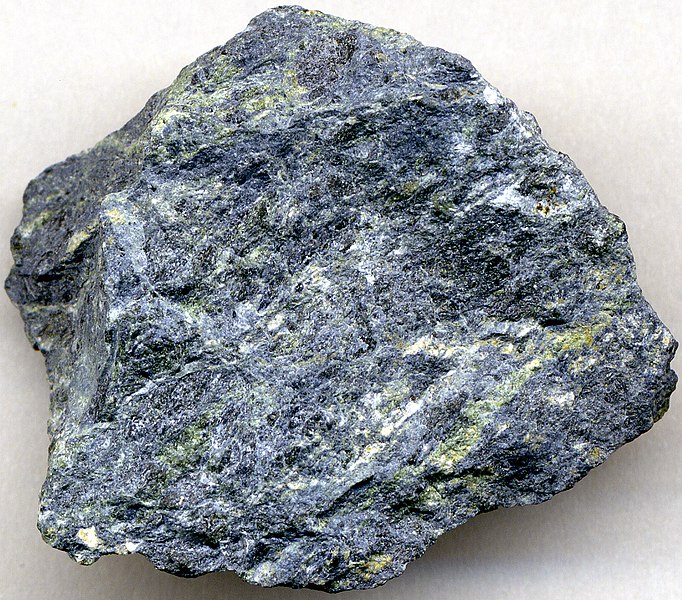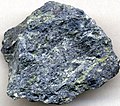File:Blueschist (Franciscan Complex, mid-Cretaceous; Jenner, California, USA) (16736795329).jpg

Original file (1,096 × 964 pixels, file size: 1.89 MB, MIME type: image/jpeg)
Captions
Captions
Summary
[edit]| DescriptionBlueschist (Franciscan Complex, mid-Cretaceous; Jenner, California, USA) (16736795329).jpg |
Blueschist (glaucophane schist; glaucophanite) (3.4 centimeters across at its widest) Metamorphic rocks result from intense alteration of any previously existing rocks by heat and/or pressure and/or chemical change. This can happen as a result of regional metamorphism (large-scale tectonic events, such as continental collision or subduction), burial metamorphism (super-deep burial), contact metamorphism (by the heat & chemicals from nearby magma or lava), hydrothermal metamorphism (by superheated groundwater), shear metamorphism (in or near a fault zone), or shock metamorphism (by an impact event). Other categories include thermal metamorphism, kinetic metamorphism, and nuclear metamorphism. Many metamorphic rocks have a foliated texture, but some are crystalline or glassy. Schist is an intermediate- to high-grade, foliated metamorphic rock. It is highly variable in appearance, depending on the mineral content, which is a function of the precursor rock and specific temperature-pressure conditions. Garden-variety schists form by metamorphism of phyllites. Schists typically have medium- to large-sized crystals, unlike the microcrystalline nature of slate & phyllite. Schist's foliated texture (= crystals aligned into bands or stripes or layers) is often only seen when specimens are viewed on edge. Blueschist (a.k.a. glaucophane schist; a.k.a. glaucophanite) is a scarce, glaucophane-rich rock. It is a classic example of a low-temperature, high-pressure metamorphic rock. The bluish material is the mineral glaucophane (Na2Mg3Al2Si8O22(OH)2 - sodium magnesium hydroxy-aluminosilicate). Calling this particular rock sample a “schist” is misleading, because it lacks schistose texture. This sample comes from a blueschist knocker (as they’re called) in serpentinitic melange of the Franciscan Complex (mid-Cretaceous) at Jenner, western coastal California, USA. The Jenner, California area is famous for its outcrops of blueschist and eclogite. Blueschists form by deep burial metamorphism of basaltic oceanic crust in subduction zones. |
| Date | |
| Source | Blueschist (Franciscan Complex, mid-Cretaceous; Jenner, California, USA) |
| Author | James St. John |
Licensing
[edit]- You are free:
- to share – to copy, distribute and transmit the work
- to remix – to adapt the work
- Under the following conditions:
- attribution – You must give appropriate credit, provide a link to the license, and indicate if changes were made. You may do so in any reasonable manner, but not in any way that suggests the licensor endorses you or your use.
| This image was originally posted to Flickr by James St. John at https://flickr.com/photos/47445767@N05/16736795329 (archive). It was reviewed on 1 December 2019 by FlickreviewR 2 and was confirmed to be licensed under the terms of the cc-by-2.0. |
1 December 2019
File history
Click on a date/time to view the file as it appeared at that time.
| Date/Time | Thumbnail | Dimensions | User | Comment | |
|---|---|---|---|---|---|
| current | 09:07, 1 December 2019 |  | 1,096 × 964 (1.89 MB) | Ser Amantio di Nicolao (talk | contribs) | Transferred from Flickr via #flickr2commons |
You cannot overwrite this file.
File usage on Commons
There are no pages that use this file.
Metadata
This file contains additional information such as Exif metadata which may have been added by the digital camera, scanner, or software program used to create or digitize it. If the file has been modified from its original state, some details such as the timestamp may not fully reflect those of the original file. The timestamp is only as accurate as the clock in the camera, and it may be completely wrong.
| Pixel composition | RGB |
|---|---|
| Orientation | Normal |
| Horizontal resolution | 800 dpi |
| Vertical resolution | 800 dpi |
| Software used | Adobe Photoshop CS2 Macintosh |
| File change date and time | 23:32, 24 March 2015 |
| Color space | Uncalibrated |
| Image width | 1,096 px |
| Image height | 964 px |
| Date and time of digitizing | 19:32, 24 March 2015 |
| Date metadata was last modified | 19:32, 24 March 2015 |